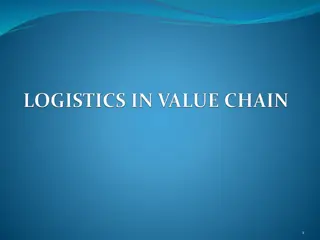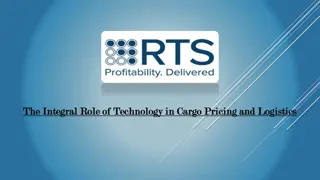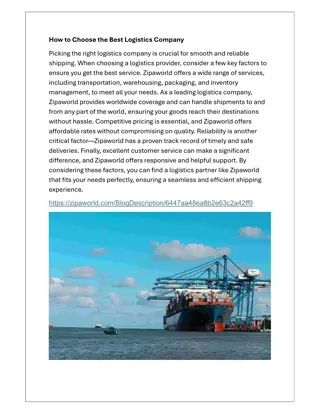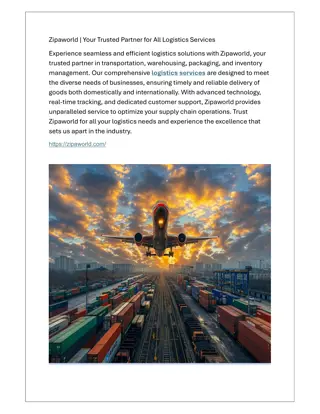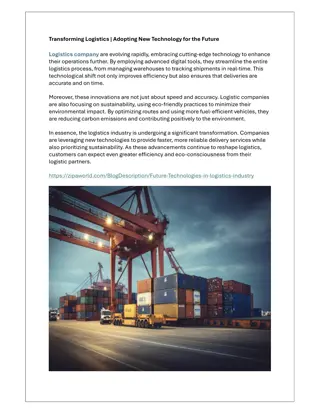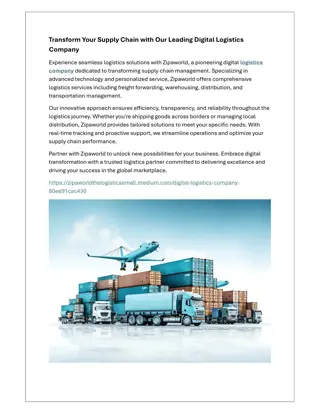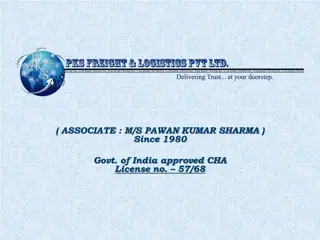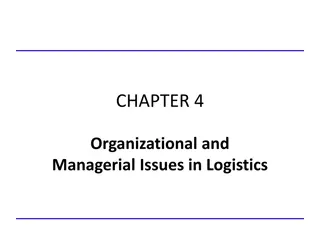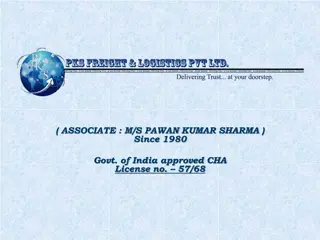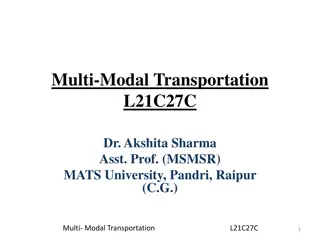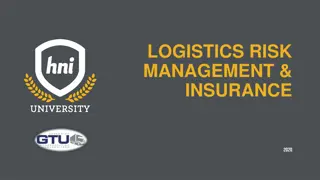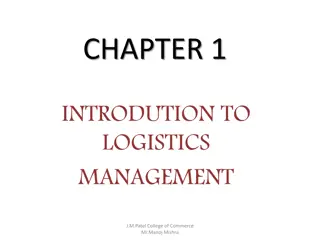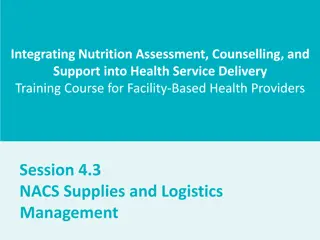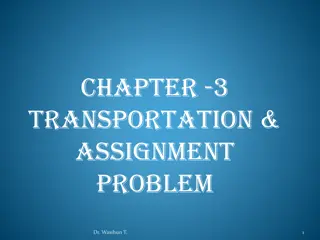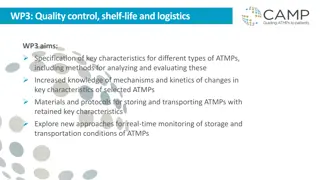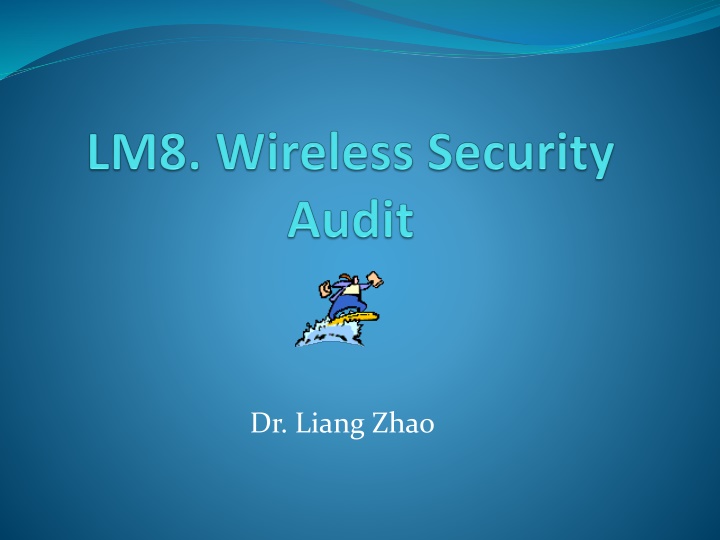
Transportation and Logistics Insights
Delve into the world of transportation and logistics with Robert Karashin, exploring supply chain management, logistics, transportation, and the career path of a logistician. Discover important definitions, fun facts, and career insights in this comprehensive overview.
Download Presentation

Please find below an Image/Link to download the presentation.
The content on the website is provided AS IS for your information and personal use only. It may not be sold, licensed, or shared on other websites without obtaining consent from the author. If you encounter any issues during the download, it is possible that the publisher has removed the file from their server.
You are allowed to download the files provided on this website for personal or commercial use, subject to the condition that they are used lawfully. All files are the property of their respective owners.
The content on the website is provided AS IS for your information and personal use only. It may not be sold, licensed, or shared on other websites without obtaining consent from the author.
E N D
Presentation Transcript
Road Map Mobile Security Security Auditing & Risk Analysis WLAN Security Introduction Mobile Network Overview (optional) Evolution of Wireless Network WLAN Overview Evolution of Cloud Cellular Network Security (optional) Infor. Security Essentials WLAN Threats & Vulnerabilities Confidentiality and Inte grity of Cloud Mobile Security Threats WLAN Security Cloud Threats & Vulner abilities WLAN Security Tools Mobile Devices Security (optional) Cloud Security 2
Learning Outcomes After this module, a student will be able to: Explain what is security audit Identify the types of security audit Discuss the best practices for security audit Discuss the purpose of security audit Discuss the tools used for security audit 3
What is a security audit? A systematic evaluation of the security of a company's information system by measuring how well it conforms to an established set of criteria. Assesses the security of the system's physical configuration and environment, software, information handling processes and user practices 4
What is a security audit used for? Security audits are often used to determine compliance with regulations that specify how organizations must deal with information. Ex. Health Insurance Portability and Accountability Act (HIPPA), the Sarbanes-Oxley Act and the California Security Breach Information Act, General Data Protection Regulation (GDPR) 5
one of three main types of security diagnostics Security audits: measure an information system's performance against a list of criteria. Vulnerability assessment: comprehensive study of an information system, seeking potential security weaknesses. Penetration testing: covert approach in which a security expert tests to see if a system can withstand a specific attack. Each approach has inherent strengths and using two or more in conjunction may be the most effective approach. 6
Why do a security audit? Identify security problems and gaps, as well as system weaknesses. Establish a security baseline that future audits can be compared with. Comply with internal organization security policies. Comply with external regulatory requirements. Determine if security training is adequate. Identify unnecessary resources. 7
Why do a security audit? Security audits will help protect critical data Identify security loopholes Create new security policies Track the effectiveness of security strategies. Regular audits can help ensure employees stick to security practices and can catch new vulnerabilities. 8
When is a security audit needed? How often an organization does its security audits depends on the industry it is in, the demands of its business and corporate structure, and the number of systems and applications that must be audited Many companies will do a security audit at least once or twice a year. But they can also be done monthly or quarterly. 9
When is a security audit needed? Different departments may have different audit schedules, depending on the systems, applications and data they use. Quarterly or monthly audits may be more than most organizations have the time or resources for, however. The determining factors in how often an organization chooses to do security audits depends on the complexity of the systems used and the type and importance of the data in that system. 10
When is a security audit needed? An organization should conduct a special security audit after a data breach, system upgrade or data migration, or when changes to compliance laws occur, when a new system has been implemented or when the business grows by more than a defined amount of users. These one-time audits may focus on a specific area where the event may have opened security vulnerabilities. For example, if a data breach just occurred, an audit of the affected systems can help determine what went wrong. 11
Types of security audits Internal audits. In these audits, a business uses its own resources and internal audit department. Internal audits are used when an organization wants to validate business systems for policy and procedure compliance. External audits. With these audits, an outside organization is brought in to conduct an audit. External audits are also conducted when an organization needs to confirm it is conforming to industry standards or government regulations. 12
What systems does an audit cover? Network vulnerabilities. Auditors look for weaknesses in any network component that an attacker could exploit to access systems or information or cause damage. Information as it travels between two points is particularly vulnerable. Security audits and regular network monitoring keep track of network traffic, including emails, instant messages, files and other communications. Network availability and access points are also included in this part of the audit. Security controls. With this part of the audit, the auditor looks at how effective a company's security controls are. That includes evaluating how well an organization has implemented the policies and procedures it has established to safeguard its information and systems. For example, an auditor may check to see if the company retains administrative control over its mobile devices. The auditor tests the company's controls to make sure they are effective and that the company is following its own policies and procedures. 13
What systems does an audit cover? Encryption. This part of the audit verifies that an organization has controls in place to manage data encryption processes. Software systems. Here, software systems are examined to ensure they are working properly and providing accurate information. They are also checked to ensure controls are in place to prevent unauthorized users from gaining access to private data. The areas examined include data processing, software development and computer systems. Architecture management capabilities. Auditors verify that IT management has organizational structures and procedures in place to create an efficient and controlled environment to process information. 14
What systems does an audit cover? Telecommunications controls. Auditors check that telecommunications controls are working on both client and server sides, as well as on the network that connects them. Systems development audit. Audits covering this area verify that any systems under development meet security objectives set by the organization. This part of the audit is also done to ensure that systems under development are following set standards. Information processing. These audits verify that data processing security measures are in place. 15
Steps involved in a security audit Agree on goals. Include all stakeholders in discussions of what should be achieved with the audit. Define the scope of the audit. List all assets to be audited, including computer equipment, internal documentation and processed data. Conduct the audit and identify threats. List potential threats related to each Threats can include the loss of data, equipment or records through natural disasters, malware or unauthorized users. Evaluate security and risks. Assess the risk of each of the identified threats happening, and how well the organization can defend against them. Determine the needed controls. Identify what security measures must be implemented or improved to minimize risks. 16
Reference https://searchcio.techtarget.com/definition/security- audit https://www.tutorialspoint.com/wireless_security/wir eless_security_tools.htm 17

